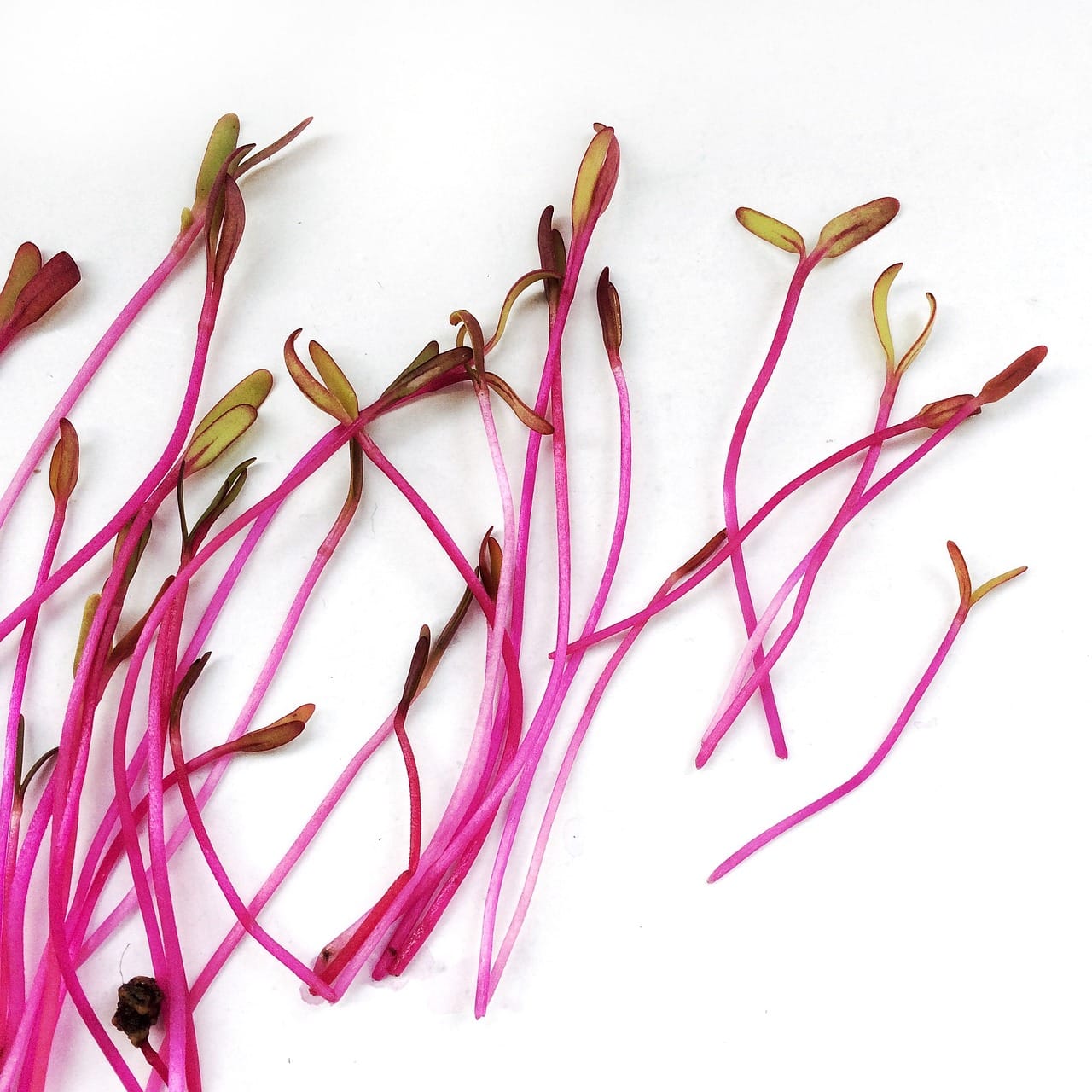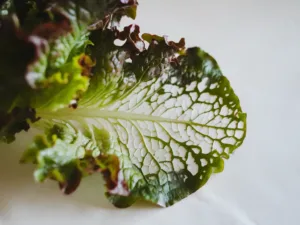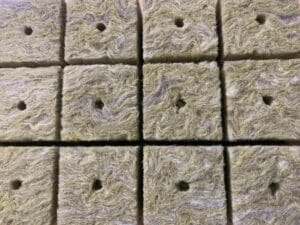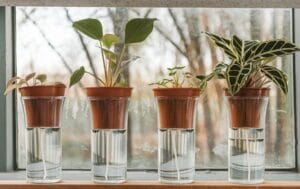Red beet microgreens are a true highlight for anyone interested in growing microgreens. Not only are they stunning with their deep red stems and vibrant green to purple leaves, but they’re also packed with nutrients. These tiny powerhouses are full of vitamins, minerals, and antioxidants that make your food not only more colorful but healthier, too.
So why should you grow red beet microgreens in your hydroponic system? The answer is simple: their intense flavor, which is earthy yet slightly sweet, adds a special note to salads, sandwiches, and smoothies. They’re also relatively easy to care for and thrive even in dense growth, making them ideal for growing on substrate mats. Let’s dive into which varieties, systems, and conditions are ideal for successful growth!
Choosing the Right Variety: Which Red Beet Varieties Are Suitable for Microgreens?
Not all red beet varieties are the same, especially when it comes to microgreens. While all varieties are known and loved in their mature form, some are particularly suited as microgreens. Here are three to five varieties to consider:
- ‘Bull’s Blood’: This variety is known for its deep red leaves and intense flavor. It grows quickly and develops beautiful, contrasting colors that give your dishes a special visual appeal. Ideal for anyone looking for a bold flavor and great colors.
- ‘Detroit Dark Red’: A classic variety that’s also very popular as a microgreen. It has a good germination rate and a slightly sweet aroma. This variety is versatile and well-suited for various hydroponic substrate methods.
- ‘Golden Beet’: This yellow beet variety has a milder, slightly nutty flavor. It grows a bit slower but is especially attractive for its unique taste and golden-yellow color.
- ‘Chioggia’: Known for its red and white ring patterns as a mature beet, it also brings a certain finesse as a microgreen. The flavor is sweet and mild, perfect for smoothies and as a garnish.
- ‘Cylindra’: This variety is long and narrow, ideal for dense growing areas. It grows quickly and produces uniform microgreens with an earthy flavor that pairs well with savory dishes.
Your choice of variety depends on your preferences—whether you prioritize intense flavor, unique colors, or a fast growth rate.
Hydroponic Systems for Red Beet Microgreens: Which Systems Work?
Unlike many other hydroponic plants, microgreens such as red beet are grown on substrate mats. This is because microgreens thrive in dense, shallow growth and are harvested within one to three weeks. Classic hydroponic systems like the Nutrient Film Technique (NFT) or Deep Water Culture (DWC) are less suitable for this growing method.
Instead, ebb and flow systems are recommended, where a thin layer of nutrient solution periodically moistens the roots. These systems ensure consistent moisture and provide a stable growth environment. Alternatively, passive water level systems can also be used, where the substrate mat is continuously kept slightly moist. Both methods ensure that the roots of the red beet microgreens receive enough moisture and nutrients without sitting in water.
Growing Red Beet Microgreens: Step-by-Step Instructions
Let’s get practical! Growing red beet microgreens is simple if you follow these steps:
- Prepare the seeds: Red beet seeds have a hard seed coat, so it’s helpful to soak them in water for about 8-12 hours before sowing. This encourages faster and more even germination.
- Prepare the substrate mat: Choose a suitable substrate mat like a hemp or coconut mat. Place the mat in your chosen hydroponic system and evenly moisten it with a water-nutrient solution.
- Sow the seeds: Spread the soaked seeds evenly on the moistened substrate mat. Red beet seeds can be sown densely to make the best use of space. About 1 cm spacing between seeds is sufficient.
- Encourage germination: Cover the seeds for the first 3-4 days to retain moisture and promote germination. Once the first sprouts appear, remove the cover and place the system in a well-lit area.
- Care and Growth: Keep the substrate mat moist and ensure the microgreens get enough light—ideally 12-16 hours a day. The ideal temperature is around 20-24°C.
- Harvest: After about 10-14 days, the red beet microgreens are ready for harvest. Cut the sprouts just above the substrate mat. For the best flavor and highest nutrient density, use them immediately after harvest or store them in the refrigerator.
The Best Substrate for Your Red Beet Microgreens
The right substrate is essential for successful red beet microgreen cultivation. Unlike mature plants, microgreens need a substrate that stabilizes the roots while providing good moisture retention and airflow.
- Hemp Mats: These are biodegradable and offer excellent water retention without becoming too wet. Hemp mats are a good choice for both beginners and experienced gardeners as they are easy to handle.
- Coconut Mats: Made from coconut fiber, these mats offer excellent airflow, which prevents rot and mold. Coconut mats are also biodegradable and have the advantage of being easy to manage.
- Jute or Cotton Mats: These mats have a similar structure to hemp and coconut but can be more challenging to handle. They can mold easily if not properly maintained, but they also provide good moisture control.
Your choice of substrate depends on your preference and experience. In general, look for a substrate that balances water retention with airflow.
Optimal Temperature and Light Conditions for Healthy Growth
Red beet microgreens are hardy, but like all plants, they need the right conditions to thrive. The temperature should be between 20-24°C. At lower temperatures, growth slows down significantly, and at higher temperatures, there is a risk of wilting or mold.
Lighting is also crucial. Red beet microgreens need about 12-16 hours of light per day. A combination of natural and artificial light works best. If you don’t have direct sunlight, LED grow lights are an excellent alternative as they are energy-efficient and provide even lighting.
Avoid exposing the plants to direct sunlight as this can cause excessive heat. Rotate the plants regularly if you use only one light source to encourage even growth.
pH & EC Levels: What to Watch Out For with Red Beet Microgreens
The correct pH level of the nutrient solution is crucial for the healthy growth of red beet microgreens in a hydroponic system. The ideal pH for microgreens is between 6.0 and 6.5. Too low or too high pH levels can affect nutrient absorption and slow down growth.
Electrical conductivity (EC) should also be monitored. An EC value of 1.2 to 1.6 mS/cm is optimal for red beet microgreens. Higher levels can lead to over-fertilization, which can be especially harmful to young plants. Use a pH and EC meter to check these values regularly and adjust as needed.
Fertilizing Red Beet Microgreens: How Much Is Too Much?
Microgreens generally don’t require a lot of fertilizer as they obtain most of their nutrients from the seed. Too much fertilizer can damage the delicate seedlings and even cause burns.
A light fertilization with a diluted hydroponic nutrient solution (about one-quarter of the usual concentration) is more than sufficient. Use a balanced nutrient solution that includes both macro and micronutrients. Reduce fertilization if the plants show yellow leaves or burnt tips, and rinse the substrate with clear water as needed.
Harvesting for Maximum Flavor and Nutrient Content
The ideal time to harvest red beet microgreens is about 10 to 14 days after sowing, when the first true leaves appear. At this point, nutrients are most concentrated, and the flavor is intense and rich.
Use a sharp pair of scissors or a knife to cut the microgreens just above the substrate mat. Be careful not to pull or tear the microgreens to avoid disturbing the substrate and remaining plants. After harvesting, it’s best to use the microgreens right away or store them in an airtight container in the refrigerator to preserve freshness and nutrients.
Diseases and Pests: How to Protect Your Microgreens
Although red beet microgreens are relatively resistant compared to other plants, they can still be affected by diseases and pests. The most common problems are mold and fungi, which arise from excessive moisture and poor ventilation.
- Preventing Mold: Avoid over-wetting the substrate mat and ensure good air circulation. A small fan can work wonders here.
- Controlling Fungi: If you already have a fungal infestation, you can treat the affected areas with a mixture of water and vinegar or hydrogen peroxide.
- Pest Control: In case of an infestation by fungus gnats or other small insects, yellow sticky traps and biological agents like neem oil can help keep the population in check.
Special Tips for Growing Red Beet Microgreens
- Sow densely for a rich harvest: Microgreens grow best in dense stands. Don’t hesitate to spread the seeds generously to achieve a full harvest.
- Regulate humidity: High humidity can promote germination but also mold growth. Use hygrometers to monitor and ensure good ventilation.
- Innovative growing methods: Experiment with different substrate types or try growing microgreens in vertical systems to make optimal use of space in your setup.
Why You Should Definitely Add Red Beet Microgreens to Your Setup
Red beet microgreens are not only visually appealing but also a real superfood. They are easy to grow, quick to harvest, and a great addition to any kitchen. Whether you use them in salads, smoothies, or as a garnish—they bring color, flavor, and health to your daily routine. Start growing your own red beet microgreens and experience the difference!







